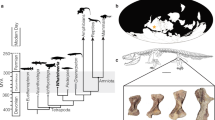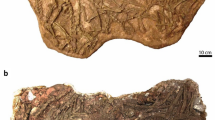Abstract
ANNUAL growth rings are often found in the skeletal tissues of Recent and fossil ectothermic vertebrates1,2. These rings are usually attributed to the inability of ectotherms to maintain high levels of activity, feeding and growth during adverse times, such as dry seasons in tropical areas and cold seasons at higher, more temperate latitudes1. In endothermic vertebrates, however, the efficient production of endogenous heat results in a relatively constant body temperature, and high activity and feeding levels are more easily sustained. Consequently, the growth of skeletal tissues in these animals is less sensitive to seasonal variations than in ectotherms, and annulations are rare except in species living under severe seasonal regimes3,4. Many workers have proposed that dinosaurs were endothermic, as are all living mammals and birds, rather than ectothermic, as are all living reptiles3,5–10. In accordance with this hypothesis, pronounced seasonal growth rings have not been observed in the calcified tissues of dinosaurs5,6. However, here I report the discovery of such rings in the teeth of diverse Late Cretaceous dinosaurs.
Similar content being viewed by others
References
Peabody, F. E. J. Morph. 108, 11 (1961).
Warren, J. W. Diss. Abstr. 24, 908 (1963).
Bakker, R. T. Scient. Am. 232, 58 (1975).
Morris, P. Mam. Rev. 2, 69 (1972).
Ricqlès, A. de Evol. Theory 1:51 (1974).
Ricqlès, A. de in Morphology and Biology of Reptiles No. 3 (eds Bellairs, A. d'A. & Cox, C. V.) 123 (Linn. Soc. Symp. Ser., 1976).
Bakker, R. T. Evolution 25, 636 (1971).
Bakker, R. T. Nature 238, 81 (1972).
Ostrom, J. H. Evolution 28, 491 (1974).
Dodson, P. Evolution 28, 494 (1974).
Schour, I. & Hoffman, M. M. J. dent. Res. 18, 91 (1939).
Klevezal', G. A. & Kleinenberg, S. E. (1967), Age Determination of Mammals from Annual Layers in Teeth and Bones (in Russian) (Translation by Israel Program for Scientific Translations, Jerusalem, 1969).
Morris, P. in Development Function and Evolution of Teeth (eds Butler, P. M. & Joysey, K. A.) 483 (Academic, London, 1978).
Spinage, C. A. E. Afr. Wildl. J. 5, 1 (1967).
Spinage, C. A. E. Afr. Wildl. J. 11, 165 (1973).
Simpson, C. D. & Elder, W. H. Arnoldia 4, 1 (1969).
Robinette, W. L. & Archer, A. L. E. Afr. Wildl. J. 9, 83 (1971).
Axelrod, D. I. & Bailey, H. P. Evolution 22, 595 (1968).
Estes, R. Univ. Calif. Publs Geol. Sci. 49, 1 (1964).
Dodson, P. Palaeogeog. Palaeoclimatol. Palaeoecol. 10, 10 (1971).
Author information
Authors and Affiliations
Rights and permissions
About this article
Cite this article
JOHNSTON, P. Growth rings in dinosaur teeth. Nature 278, 635–636 (1979). https://doi.org/10.1038/278635a0
Received:
Accepted:
Published:
Issue Date:
DOI: https://doi.org/10.1038/278635a0
- Springer Nature Limited
This article is cited by
-
Feeding height stratification among the herbivorous dinosaurs from the Dinosaur Park Formation (upper Campanian) of Alberta, Canada
BMC Ecology (2013)
-
Ring formation and annual growth in Corbicula consobrina Caillaud, 1827 (Bivalvia, Corbiculidae)
Hydrobiologia (1984)
-
Growth rings in dinosaur teeth
Nature (1980)
-
Growth rings in dinosaur teeth (reply)
Nature (1980)
-
Growth rings in dinosaur teeth
Nature (1980)





